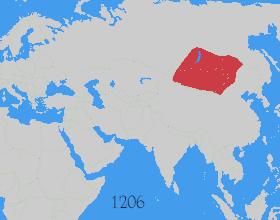The Mongol Invasions
| Mongol invasions and conquests | |||||||
|---|---|---|---|---|---|---|---|
 Expansion of the Mongol Empire 1206–94 |
|||||||
|
|||||||
Mongol invasions and conquests took place throughout the 13th century, resulting in the vast Mongol Empire, which by 1300 covered much of Asia and Eastern Europe. Historians regard the destruction under the Mongol Empire as results of some of the deadliest conflicts in human history. In addition, Mongol expeditions brought the bubonic plague along with them, spreading it across much of Asia and Europe and helping cause massive loss of life in the Black Death of the 14th century.
The Mongol Empire developed in the course of the 13th century through a series of conquests and invasions throughout Asia, reaching Eastern Europe by the 1240s. In contrast with later empires such as the British, which can be defined as "empires of the sea", the Mongol empire was an empire of the land, a tellurocracy, fuelled by the grass supporting Mongol cavalry and cattle. Thus most Mongol conquering and plundering took place during the warmer seasons, when there was sufficient grass for the herds.
Tartar and Mongol raids against Russian states continued well beyond the start of the Mongol Empire's fragmentation around 1260. Elsewhere, the Mongols' territorial gains in China continued into the 14th century under the Yuan dynasty, while those in Persia persisted into the 15th century under the Timurid Empire. In India, a Mongol state survived into the 19th century in the form of the Mughal Empire.
Genghis Khan forged the initial Mongol Empire in Central Asia, starting with the unification of the Mongol and Turkic confederations such as Merkits, Tartars, and Mongols. The Uighur Buddhist Qocho Kingdom surrendered and joined the empire. He then continued expansion of the empire via conquest of the Qara Khitai and the Khwarazmian dynasty.
...
Wikipedia
